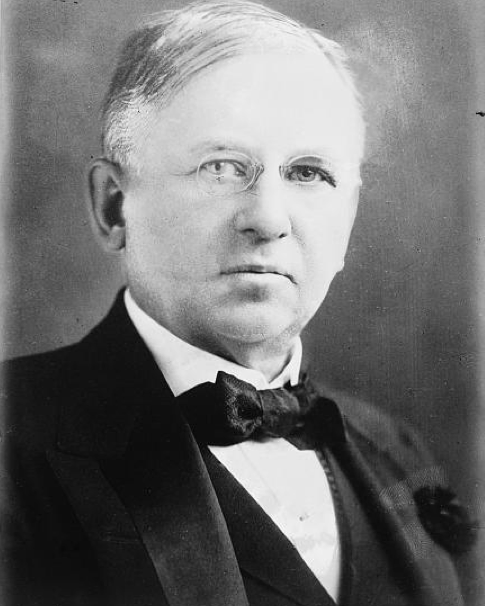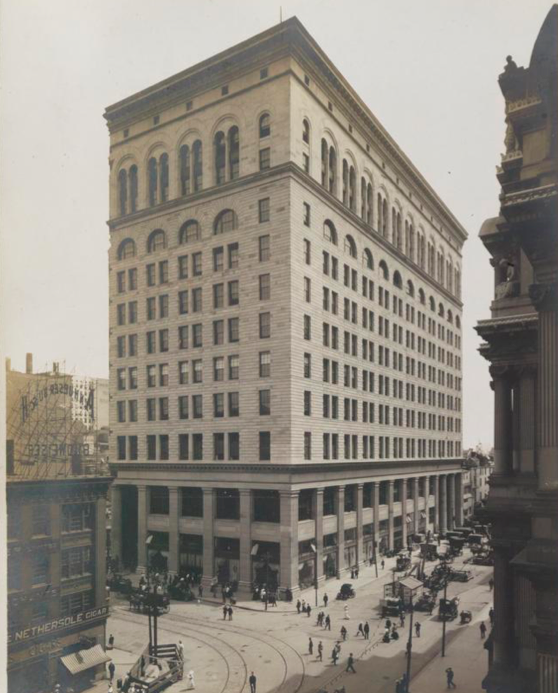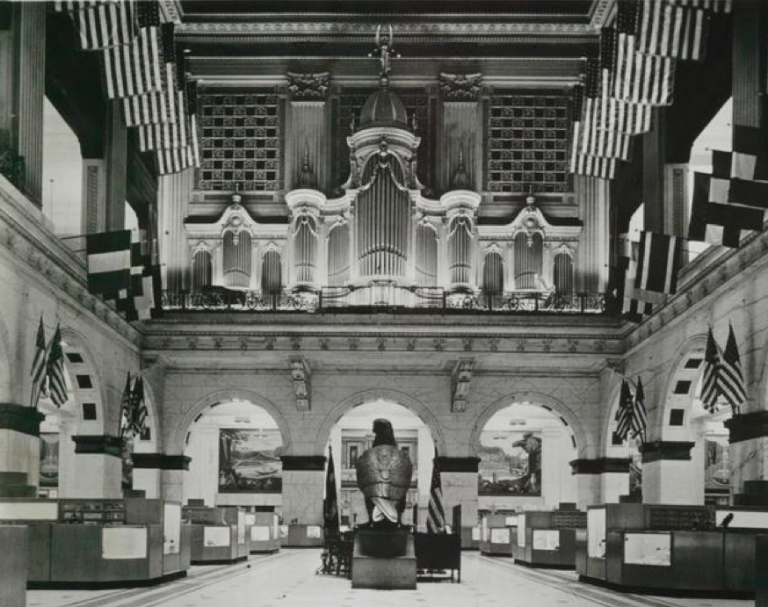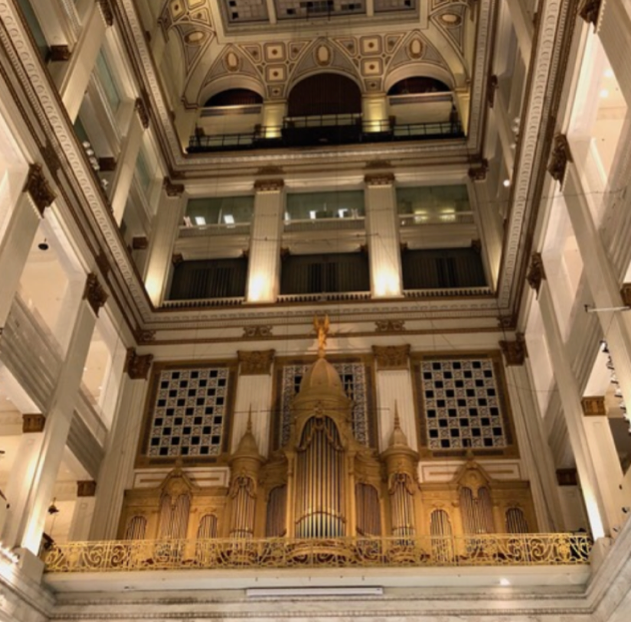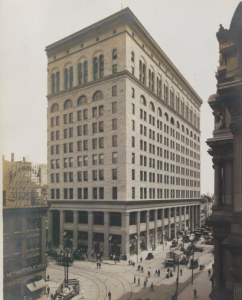Wanamaker Organ
Essay
Originally designed for the St. Louis World’s Fair of 1904, the organ purchased by John Wanamaker (1838-1922) for his unprecedented Philadelphia department store at Thirteenth and Market Streets expanded over time to produce the sound power of three symphony orchestras. Regarded as the largest playable instrument in the world, the Wanamaker Grand Court Organ remained a highlight of the Center City store that became Macy’s in 2006.
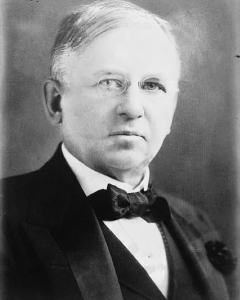
Renowned artist and architect George Ashdown Audsley (1838-1925) designed the organ, which was built by the Los Angeles Art Organ Company for the Louisiana Purchase Exposition (the St. Louis World’s Fair), held from April 30 to December 1, 1904. Construction of the organ cost $105,000—a 2018 value of approximately $2,824,521—which eventually bankrupted the builder. For the duration of the fair, the organ entertained fairgoers with grandiose musical performances in Festival Hall. However, after the fair, plans to have it permanently installed at the Kansas City Convention Center or exhibited at Coney Island fell through, and the organ languished in storage, unused for the next five years.
Wanamaker went to great lengths to implement innovative policies and architectural features in his store, not only to draw customers but more importantly to ensure their satisfaction with their overall experience. After attending the St. Louis fair, he purchased Germany’s six-foot, six-inch bronze eagle by August Gaul (1869-1921)—an emblem of craftsmanship—to display in the store. A firm believer in the ability of music to improve employee and shopper disposition and store atmosphere, Wanamaker proceeded to purchase the organ in 1909. Transporting it to Philadelphia required thirteen freight cars and, along with other improvements and renovations to the store, it took two years to complete installation of the organ in the store’s 149-foot-high, marble-clad center, the Grand Court of Honor. John’s son Rodman Wanamaker (1863–1928) considered the store—an architectural marvel of its era—the ideal place for the “finest organ in the world.” Wanamaker’s official opening of the newly remodeled store and the Wanamaker Organ’s dedication in 1911 drew a crowd of over forty thousand people, including President William Howard Taft (1857-1930).
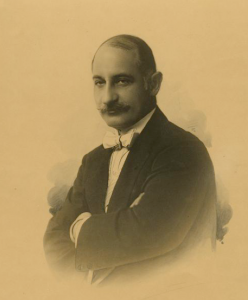
As an advocate for the arts, Rodman (like his father) believed that music would improve the experiences of both shoppers and employees; however, even with its more than 10,000 pipes, Rodman deemed the organ insufficient in size and sonority to fill the Grand Court with its warm music. He ordered an extensive enlargement, resulting in 17,222 pipes by 1917. To increase organ-expansion efficiency, an organ shop was built in the attic of the two-million-square-feet building and employed a full-time staff of organ builders. Subsequent expansions eventually produced a 287-ton organ with almost 29,000 pipes ranging from 1 inch to 32 feet in length. Although the Wanamaker Grand Court Organ’s ultimate size fell about 2,000 pipes short of the total of the Boardwalk Hall Auditorium Organ in Atlantic City, New Jersey, the Wanamaker organ remained 100 percent operational and thus became recognized as the largest playable instrument in the world. Most organs of its size and age deteriorated over time; the Boardwalk Hall Auditorium Organ, for example, maintained 50 percent functionality.
With its 466 stops (ranks of pipes), the Wanamaker organ could reproduce the sound of numerous string and woodwind instruments and horns, including but not limited to violins, cellos, flutes, oboes, clarinets, French horns, tubas, and trombones, giving it the ability to produce the all-encompassing sound power of three entire symphonies. Over the years, famous organists sought to play classical as well as signature pieces written specifically for the organ, including Charles M. Courboin (1884–1973), the organist from 1919 to 1929 for evening concerts, special events, and performances accompanied by the Philadelphia Orchestra. A favorite among the Wanamaker organists, he oversaw the second enlargement of the organ in 1924.
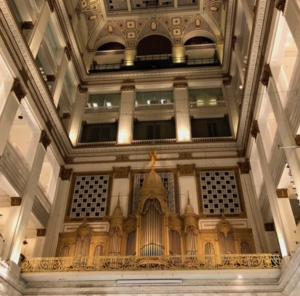
The organ shop in the store continued to maintain and improve the organ, aided by a volunteer restoration team. However, after Rodman Wanamaker died, ownership of the store changed multiple times and the organ fell into disrepair. The Friends of the Wanamaker Organ, a nonprofit organization dedicated to the organ’s history and prominence, formed in 1991 to provide tours and information and to raise funds for organ maintenance. Wanamaker Organ Day, an annual free post-Memorial Day concert, began in 1994 and featured guest performers who conducted several concerts throughout the day with supplementary brass and percussion instruments and a chorus.
Macy’s continued to carry out many of the Wanamaker Organ traditions, including Wanamaker Organ Day. Since 2008, the organ has been fully refurbished. More than a century after the organ arrived at John Wanamaker’s department store, daily afternoon and evening performances (excluding Sunday) and special and seasonal event performances continued to fill the Grand Court with orchestra-like music.
Breanna Ransome graduated with her Master of Arts in English from Rutgers University–Camden in May 2019. (Author information current at time of publication.)
Copyright 2019, Rutgers University
Gallery
Backgrounders
Connecting Headlines with History
- Mighty Wanamaker pipe organ going strong in 100th year (WHYY, June 23, 2011)
- Does Philadelphia or Atlantic City have the largest pipe organ? (WHYY, April 11, 2012)
- Philly Love Note: the Wanamaker Building (WHYY, December 24, 2012)
- Inside the Wanamaker organ with caretaker and craftsman Scott Kip (WHYY, June 4, 2013)
- Organ concert marks the end of Macy's era at the Wanamaker Building (WHYY, March 24, 2025)
Links
- Friends of the Wanamaker Organ
- Inside the Wanamaker Organ (Philadelphia Daily News via YouTube)
- Wanamaker Organ Flash Opera at Macy's (YouTube)
- In The Grand Tradition: The Wanamaker Organ At Christmas (Hidden City Philadelphia)
- Sixty Years Of Holiday Cheer At Wanamaker’s (Hidden City Philadelphia)
- The Sound and Fury of Philadelphia's Wanamaker Organ (Smithsonian.com)
- PhilaPlace: 1926 Lombard Street, John Wanamaker — Merchant and Community Member (Historical Society of Pennsylvania)
- Founder of the PGA, This Philadelphian Also Ran One of the City's Most Famous Department Stores. Who Was He? (Historical Society of Pennsylvania)
- PhilaPlace: Wanamaker's Department Store: Wanamaker's — Philadelphia's Largest Department Store (Historical Society of Pennsylvania)
- Wanamaker Building (Atlas Obscura)
